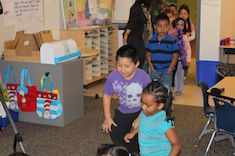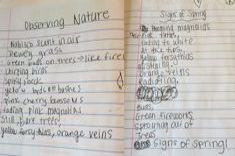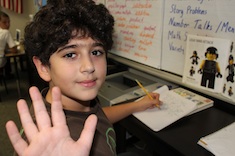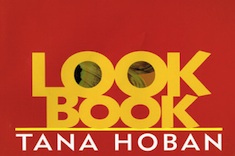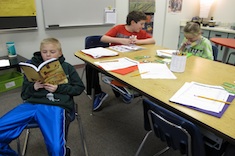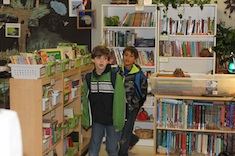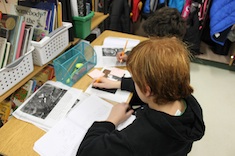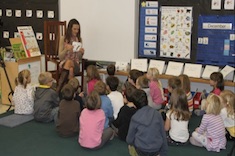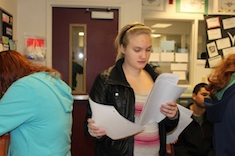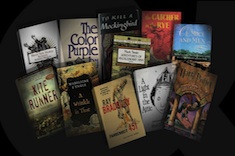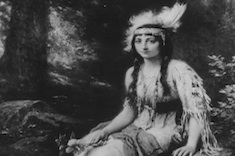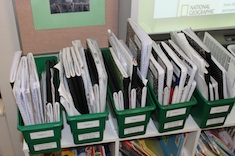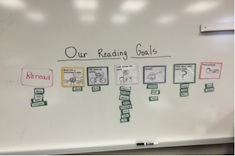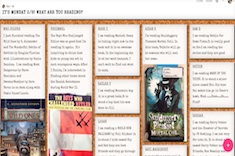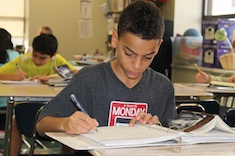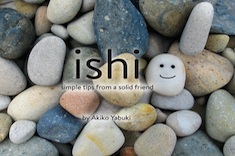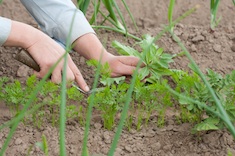Articles
Here is where you’ll find all the latest print features from our contributors. If you’d like to browse specifically by grade level, topic, or contributor, you can use the links in the right sidebar.
Latest Content
Parent in a Foreign Land
Jennifer Schwanke shares some of the unique struggles parents of English language learners have in making their children's needs known, and how we can help them.
Environment and English Language Learners
Stella Villalba finds English language learners struggle less when teachers understand what adaptations are needed in the classroom environment.
The Craft of Blogging
Franki Sibberson uses a micro-progression of her own draft of a blog post to help her third graders improve their blogging skills.
The Importance of Audience
Julie Johnson demonstrates how teachers can help students think through issues of audience during writing workshops.
Branding Blogs (Part 1)
Andrea Smith finds "branding" is a way to improve student blogs. She shares her process of presenting the concept to students in the first installment of a three-part series.
Top 10 Conferring Tips
Ruth Ayres gives her best advice for honing your conferring skills with this succinct list of tips for better conferences.
Student-Led Conferences from Many Perspectives
Jennifer Schwanke and Franki Sibberson share four perspectives on student-led conferences — teacher, principal, student, and parent.
Random Poetry
Gretchen Schroeder finds creative ways to pique interest in poetry in her high school classroom.
Not Just in April: Poetry All Year Long
Tara Smith finds that the 20 minutes she spends on poetry reading, analysis, and response in her sixth-grade classroom each week pay dividends all year long.
Poetry Through Song
Jennifer Schwanke finds song lyrics are one way for students to see the power of poems.
The Importance of Their Words
Melanie Meehan shares strategies and prompts for helping easily distracted young learners focus in conferences.
Bad Days in Workshops
Franki Sibberson realizes there are some bad days in literacy workshops that hold no great life lessons for teachers and students, and that is okay.
Playful Texts for Beginning Readers
Shari Frost uses playful texts to increase interest and stamina in emergent readers. She shares many of her favorites in this booklist.
An Identity of Success
Mary Lee Hahn is a bit flummoxed when a parent asks about her management system at an open house. The experience sparks reflection on what makes a classroom community gel.
Loving Books or Reading?
Justin Stygles wonders why a love of books doesn't necessarily translate into a love of reading for his fifth and sixth graders.
Bridging the Gap Between Intervention and the Classroom
Kate Mills and Tara Barnett share strategies for building bridges between intervention and classroom instruction.
Toward More Meaningful Extension Activities
Shari Frost challenges assignments in reading workshop that kill a love of wordplay and vocabulary development.
Teaching Punctuation with Poetry
Melanie Meehan discovers that the spare form of poetry is especially useful for teaching conventions.
An Unconventional Scavenger Hunt: Finding Errors
Jennifer Schwanke finds that a scavenger hunt for errors to add to a bulletin board is a great way to build editing skills and a writing community all year long in her seventh-grade classroom.
Beyond the Comfort Zone: Books for Our Times
Christy Rush-Levine explains why she stocks some books in her middle school classroom library that can provoke concerns from families, and how she deals with conflicts.
Replicating or Deepening?
Jennifer Schwanke finds teachers can get territorial about texts, “claiming” them for their grade level. She explores when it is appropriate to repeat the use of a text in subsequent grades.
The Pocahontas Ewww: Writing and Inquiry for Context
Mark Levine finds his middle school students are appalled by some of the cultural differences from times gone by, and shares how he fosters more understanding.
How to Keep Conferring Notes
Ruth Ayres shares her grid notes sheet, and takes teachers step-by-step through the process of using this assessment tool in conferences and instruction.
Finding Clues in Writing Folders
Katrina Edwards looks for clues in her first-grade students’ work and conferences to help them develop more writing stamina. She analyzes her notes to develop instructional plans.
Charts as Tools, Charts as Teachers
Tara Barnett and Kate Mills give three principles they use to help avoid the “charts as wallpaper” syndrome in their fourth-grade classroom.
Collaborative Charting in First Grade
Katie DiCesare shares examples from her first-grade classroom of collaborative charting with students.
Padlet Possibilities
Katherine Sokolowski finds that electronic charting of learning with Padlet has almost endless possibilities for use in her fifth-grade classroom.
Better Mondays Through Quick-Writes
Mark Levine uses quick-writes with his middle school students to set the expectation at the start of the week for work together that is independent, thoughtful, and conversational.
Opening the Year with Optimism
Katrina Edwards shares her plans for presenting children’s literature to help her first-grade students acquire the skills they need to be positive and proactive problem solvers.
Pulling Weeds
Leigh Anne Eck works to overcome years of student reliance on a reading incentives and rewards program by fostering reflection and intrinsic motivation with her sixth graders.
Browse Content By
Type
Category
- Assessment Tools
- Big Fresh Archives
- Booklists
- Choice Numeracy
- Classroom Design
- Common Core
- Community Building
- Conferring
- Content Literacy
- Digital Literacy
- English Language Learners
- Equity
- Family Relations
- Free Samples
- Guiding Groups
- Leadership
- Literacy Coaches
- Mentor Texts
- Minilessons
- New Teacher Mentors
- Podcasts
- Poetry
- Quote Collections
- Reading Strategies
- Self Care
- Struggling and Striving Learners
- Talking and Listening
- Teacher Study Groups
- Teaching Reading
- Teaching Writing
- Word Study and Vocabulary
Author
- Melissa Quimby
- Nawal Qarooni
- Gwen Blumberg
- Julie Cox
- The Lead Learners
- Hannah Tills
- Josie Stewart
- Ruth Metcalfe
- Mallory Messenger
- Becca Burk
- Jodie Bailey
- Vivian Chen
- Mary Brower
- Tiffany Abbott Fuller
- Stephanie Affinito
- Ruth Ayres
- Leigh Anne Eck
- Heather Fisher
- Shari Frost
- Julie Johnson
- Suzy Kaback
- Gigi McAllister
- Shirl McPhillips
- Melanie Meehan
- Cathy Mere
- Debbie Miller
- Tara Barnett and Kate Mills
- Tammy Mulligan
- Dana Murphy
- Bitsy Parks
- David Pittman
- Brenda Power
- Heather Rader
- Matt Renwick
- Mandy Robek
- Christy Rush-Levine
- Gretchen Schroeder
- Jen Schwanke
- Brian Sepe
- Katherine Sokolowski
- Stella Villalba
- Jennifer Vincent
Grade Level
Choice Literacy Membership
Articles
Get full access to all Choice Literacy article content
Videos
Get full access to all Choice Literacy video content
Courses
Access Choice Literacy course curriculum and training


